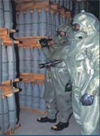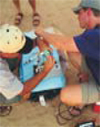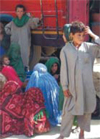Emergency and Environmental Health Services
Safeguarding people's health from environmental threats
The primary goal of CDC’s National Center for Environmental Health Division of
Emergency and Environmental Health Services (EEHS) is to provide national
leadership in the development of environmental and emergency public health
policy and prevention programs to improve public health practice nationwide.
EEHS provides consultation and technical and resource assistance, including
training, to state and local health departments and to other agencies at the
federal, state, local, and international levels.
The division also responds to national and international emergency and recovery
assistance situations, especially after natural or technologic disasters, and
provides technical support for public health activities during emergencies such
as famines, disasters, and civil strife.
EEHS activities include the following:
Built Environment
and Land Use
 |
Promotes healthy community design. Provides technical assistance
for health impact assessments (HIAs), which can be used to evaluate
objectively the potential health effects of a project or policy
before it is built or implemented. The HIA process brings public
health issues to the attention of persons who make decisions about
areas that fall outside of traditional public health arenas, such as
transportation or land use. Reviews all Environmental Impact
Assessments external to CDC. |
Chemical Weapons Elimination Team
 |
Ensures that the health and safety of workers and the general
population are protected during the handling and destruction of the
nation’s chemical weapons. Reviews all chemical weapons elimination
plans and works closely with the Department of Defense throughout
the disposal process. Evaluates the on-site medical response
capabilities to ensure that responders are prepared for any related
emergencies. |
Environmental Health Services
 |
Provides technical assistance and scientific guidance to state,
local, tribal, and other government agencies engaged in
environmental health service programs; participates in disease
outbreak investigations and identifies environmental antecedents
contributing to outbreaks; and supports, through training and
technical assistance, those environmental disciplines that have
technology or information gaps in areas such as food safety and
water and sanitation issues. |
Healthy
Homes
 |
Promotes, develops, and implements cross-disciplinary
activities at the federal, state, tribal, and community levels to
address the problem of unhealthy and unsafe housing through
surveillance, research, and comprehensive prevention programs.
Builds capacity and competency among environmental public health
practitioners, public health nurses, housing specialists, and others
who work in the community to develop and manage comprehensive and
effective healthy homes programs. |
International
Emergency and Refugee Health
 |
Coordinates CDC’s response to complex humanitarian
emergencies; provides technical assistance to other federal
agencies, the United Nations, and other organizations in areas
related to the health of refugee populations; applies epidemiologic
and public health principles to the study of complex emergencies;
works closely with international partners to identify the number and
nature of landmine-related injuries and deaths; and provides
technical assistance and training in public health emergency
planning. |
Lead Poisoning
Prevention
 |
Leads national lead poisoning prevention efforts, with emphasis on
childhood lead poisoning prevention, by working with other federal
agencies to develop an integrated national childhood lead poisoning
prevention program. Provides assistance to federal agencies, state
and community health agencies, and others in developing and
evaluating childhood lead poisoning prevention programs. Maintains a
system for the collection and dissemination of data on lead
poisoning, and conducts and evaluates epidemiologic research on
childhood lead poisoning. |
Vessel
Sanitation Program
 |
Protects passenger and crew health by developing and
implementing comprehensive sanitation programs to minimize the risk
for gastrointestinal illnesses aboard cruise ships, inspects vessels
to ensure compliance with the Vessel Sanitation Operations Manual
2005, collects and monitors reports of gastointestinal illness on
board passenger vessels to estimate illness among passengers and
detect outbreaks, and provides technical assistance to international
public health officials on public health issues related to vessel
sanitation. |









